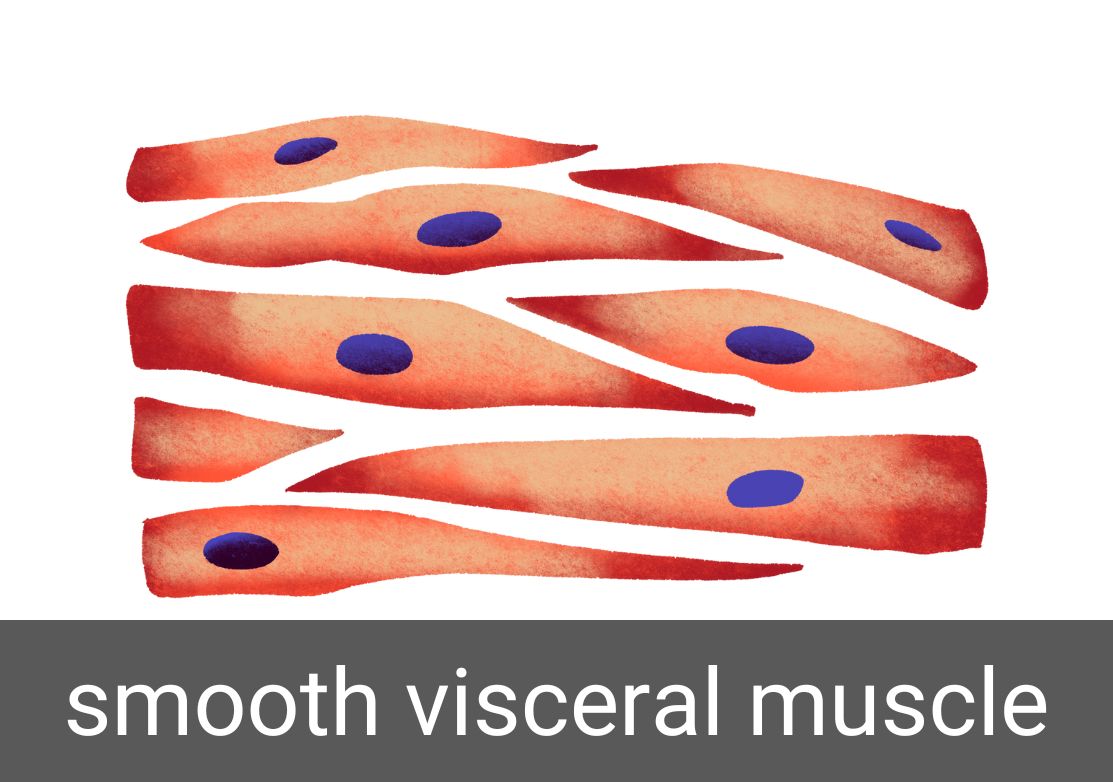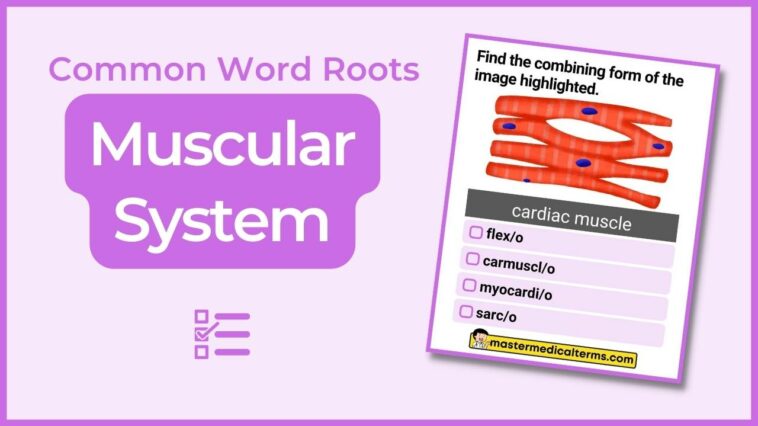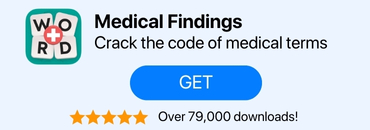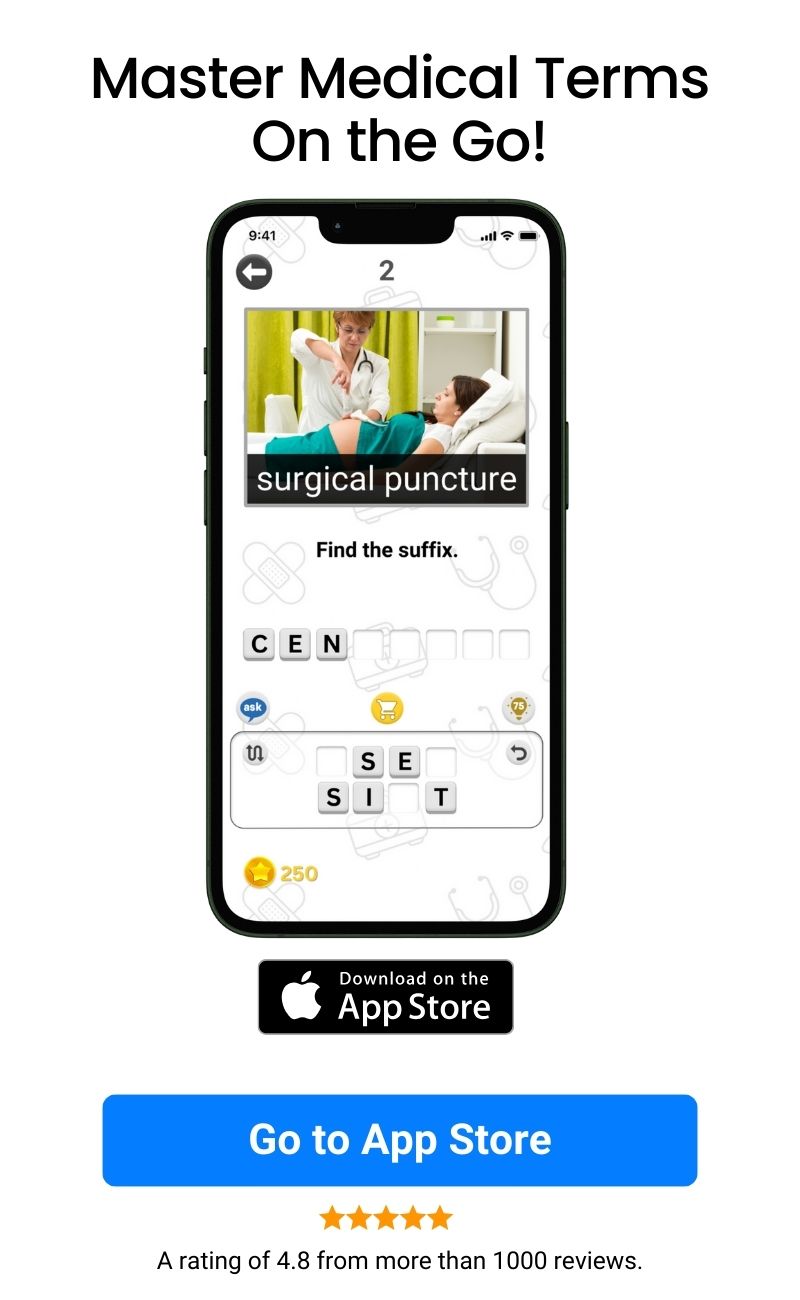In this quiz, you will learn the common word roots as well as the combining forms that are associated with the muscular system.
Quick Review for the Quiz
Check out the flashcard version for a more detailed review.
| Word Root | Combining Form | Body Part or Condition |
|---|---|---|
| fasci | fasci/o | fascia |
| flex | flex/o | bend |
| in | in/o, fibr/o | fiber |
| kin, kinesi, kinet | kin/e, kinesi/o, kinet/o | movement |
| leiomy | leiomy/o | smooth visceral muscle |
| my, myos, muscul | my/o, myos/o, muscul/o | muscle |
| myocardi | myocardi/o | cardiac muscle |
| rhabdomy | rhabdomy/o | skeletal or striated muscle |
| sarc | sarc/o | connective tissue; soft, flesh |
| ten, tendin | ten/o, tendin/o, tend/o | tendon |
| tens | tens/o | stretch; strain |
| ton | ton/o | tone |
-
Question of
Find the combining form of the image pointed to.

-
fasci/o
-
flex/o
-
ton/o
-
rhabdomy/o
Correct Wrong
fasci/o is a combining form that refers to "fascia". Fascia is a thin layer of connective tissue that encloses each organ, nerve fiber, muscle, blood vessel and bone in its proper position. In addition to providing internal structure, fascia has nerves that give it almost the same sensitivity as skin. It tends to tighten up when stressed.
-
-
Question of
Find the combining form of the image highlighted.

-
flex/o
-
bend/o
-
fasci/o
-
myocardi/o
Correct Wrong
flex/o is a combining form that refers to "bend". Bending is the process of turning from straight to curved or angular.
-
-
Question of
Find the combining form of the image highlighted.

-
in/o
-
fabr/o
-
myocardi/o
-
myos/o
Correct Wrong
in/o or fibr/o is a combining form that refers to "fiber". In the body, fiber pertains to tissue composed of strands of long cells, for example, the fibers of muscles and nerves.
-
-
Question of
Find the combining form of the image highlighted.

-
tens/o
-
stretch/o
-
fasci/o
-
sarc/o
Correct Wrong
tens/o is a combining form that refers to "stretch; strain". Tension is the process or act of stretching; the condition of being strained or stretched.
-
-
Question of
Find the combining form of the image highlighted.

-
kinesi/o
-
mov/o
-
tens/o
-
rhabdomy/o
Correct Wrong
kin/e, kinesi/o or kinet/o is a combining form that refers to "movement". In simple terms, movement is the act of moving or the change of position.
-
-
Question of
Find the combining form of the image highlighted.

-
leiomy/o
-
smooth/o
-
rhabdomy/o
-
myocardi/o
Correct Wrong
leiomy/o is a combining form that refers to "smooth visceral muscle". Smooth (visceral) muscle fibers are found in the walls of hollow internal organs (including the liver, pancreas, and intestines), with the exception of the heart. Visceral muscle allows organs to contract and move substances. A visceral muscle is controlled by the brain's unconscious part, making it an involuntary muscle.
-
-
Question of
Find the combining form of the image highlighted.

-
my/o
-
mascl/o
-
leiomy/o
-
fasci/o
Correct Wrong
my/o, myos/o or muscul/o is a combining form that refers to "muscle". Muscle refers to the tissue of the body that is composed of clusters of cells that undergo contractions and relaxation to generate movement. Three types of muscle exist in the body: skeletal (striated), smooth, and cardiac.
-
-
Question of
Find the combining form of the image highlighted.

-
myocardi/o
-
carmuscl/o
-
flex/o
-
sarc/o
Correct Wrong
myocardi/o is a combining form that refers to "cardiac muscle". Myocardium (or cardiac muscle) constitutes the thick middle layer of the heart. Only the heart contains cardiac muscle tissue, which pumps blood through the circulatory system through rhythmic contractions. Unlike skeletal muscle, cardiac muscle is characterized by rhythmic contractions and cannot be controlled voluntarily.
-
-
Question of
Find the combining form of the image highlighted.

-
rhabdomy/o
-
skelet/o
-
tens/o
-
sarc/o
Correct Wrong
rhabdomy/o is a combining form that refers to "skeletal or striated muscle". Skeletal muscles are responsible for 30 to 40% of the body's total mass. These are the muscles that attach to the bones and enable the body to execute a variety of functions and movements. Skeletal muscles are voluntary, which means an individual can control their activity. Skeletal muscle fibers are red and white in color. Their appearance is striated, or striped, which is why they are often called striated muscles.
-
-
Question of
Find the combining form of the image highlighted.

-
sarc/o
-
connect/o
-
ton/o
-
kinet/o
Correct Wrong
sarc/o is a combining form that refers to "connective tissue; soft" or "flesh". The connective tissues in the body support, protect, and give structure to other tissues and organs. Connective tissue is also responsible for storing fat, transporting nutrients and other materials between tissues and organs, and restoring damaged tissue. There are four types of connective tissue: blood, bone, cartilage, and connective tissue proper (such as fat).
-
-
Question of
Find the combining form of the image highlighted.

-
tendin/o
-
ton/o
-
in/o
-
myos/o
Correct Wrong
ten/o, tendin/o or tend/o is a combining form that refers to "tendon". Tendons are fibrous connective tissues that bind muscles to bone as well as connecting muscles to specific structures such as the eyeballs. Tendons help to facilitate the movement of the bone or structure they are attached to.
-
-
Question of
Find the combining form of the image highlighted.

-
ton/o
-
tonal/o
-
rhabdomy/o
-
flex/o
Correct Wrong
ton/o is a combining form that refers to "tone". During rest, muscle tone refers to the continuous and passive contraction of the muscle or the muscle's resistance to passive stretching.
-




